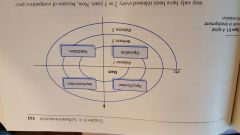![]()
![]()
![]()
Use LEFT and RIGHT arrow keys to navigate between flashcards;
Use UP and DOWN arrow keys to flip the card;
H to show hint;
A reads text to speech;
10 Cards in this Set
- Front
- Back
|
C9P241 Software evolution |
1. Evolution processes 2. Legacy systems 3. Software maintenance |
|
|
C9P243 Spiral model |

|
|
|
C9P248 Elements of a legacy system |
1. System hardware 2. Support software 3. Application software 4. Application data 5. Business processes 6. Business policies and rules |
|
|
C9P252 Legacy strategy to evolve the system. |
1. Scrap the system completely 2. Leave the system unchanged and continue with regular maintenance 3. Reengineer the system to improve its maintainability 4. Replace all or part of the system with a new system |
|
|
C9P253 Four issues to discuss of the business value of a system |
1. The use of the system 2. The business processes that are supported 3. System dependability 4. The system outputs |
|
|
C9P255 Factors used in environment assessment |
1. Supplier stability 2. Failure rate 3. Age 4. Performance 5. Support requirements 6. Maintenance cost 7. Inter-operability |
|
|
C9P256 Factors used in application assessment |
1. Understandability 2. Documentation 3. Data 4. Performance 5. Programming language 6. Configuration management 7. Test data 8. Personnel skills |
|
|
C9P257 Three different types of software maintenance |
1. Fault repairs to fix bugs and vulnerabilities 2. Environmental adaptation to adapt the software to new platforms and environments 3. Functionality addition to add new features and to support new requirements. |
|
|
C9P262 Reengineering has two important advantage over replacement |
1. Reduced risk 2. Reduced cost |
|
|
C9P265 Refactoring (bad smell) |
1. Duplicatate code 2. Long methods 3. Switch (case) statements 4. Data clumpling 5. Speculative generality |

